Instant Inspiration: Photos from The Life & Love of Trees
Extraordinary images from some of the world's leading nature photographers.
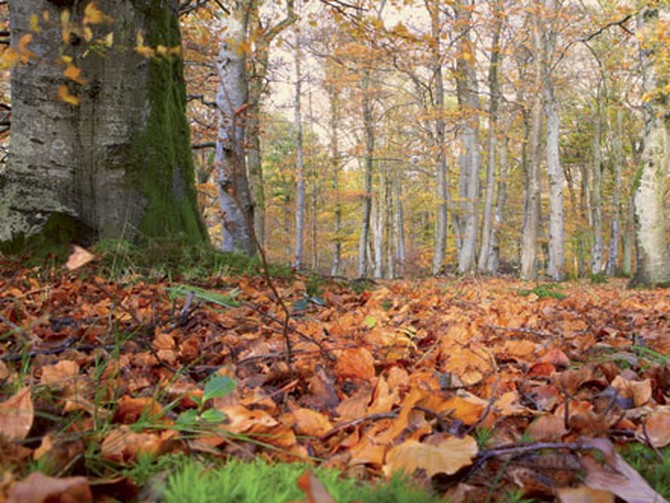
Perthshire, Scotland
Species: Fagus sylvatica
Photographer: Kathy Collins
The forest floor under these beech trees in Perthshire, Scotland, is low in undergrowth due to the heavy canopy of the trees, which prevents light reaching the ground. This creates a distinctive forest scene of heavy leaf litter late in the year and into early spring when the beech has finally shed its leaves.
From The Life & Love of Trees by Lewis Blackwell. Image © Kathy Collins
Photographer: Kathy Collins
The forest floor under these beech trees in Perthshire, Scotland, is low in undergrowth due to the heavy canopy of the trees, which prevents light reaching the ground. This creates a distinctive forest scene of heavy leaf litter late in the year and into early spring when the beech has finally shed its leaves.
From The Life & Love of Trees by Lewis Blackwell. Image © Kathy Collins
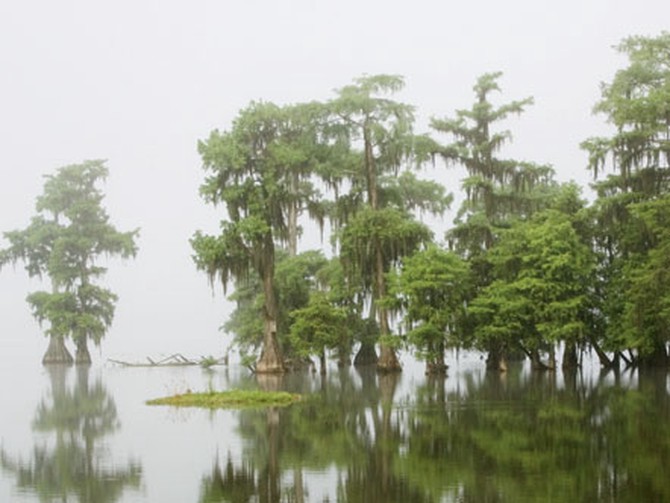
Southeastern United States
Species: Taxodium distichum
Photographer: Cece Fabbro
The bald cypress, or swamp cypress, is a species that is distinctive for growing beside and even within the shallow waters at the edge of lakes and in other flooded areas. To do this it has developed particular features to cope with the apparent suffocation of its roots underwater. Around permanently swamped trees it is possible to see "knees", small stumps from the roots, sticking up above the water. These help stabilize the tree and may also help it breathe. The appellation "bald" is given because it sheds its leaves.
From The Life & Love of Trees by Lewis Blackwell. Image © Cece Fabbro
Photographer: Cece Fabbro
The bald cypress, or swamp cypress, is a species that is distinctive for growing beside and even within the shallow waters at the edge of lakes and in other flooded areas. To do this it has developed particular features to cope with the apparent suffocation of its roots underwater. Around permanently swamped trees it is possible to see "knees", small stumps from the roots, sticking up above the water. These help stabilize the tree and may also help it breathe. The appellation "bald" is given because it sheds its leaves.
From The Life & Love of Trees by Lewis Blackwell. Image © Cece Fabbro
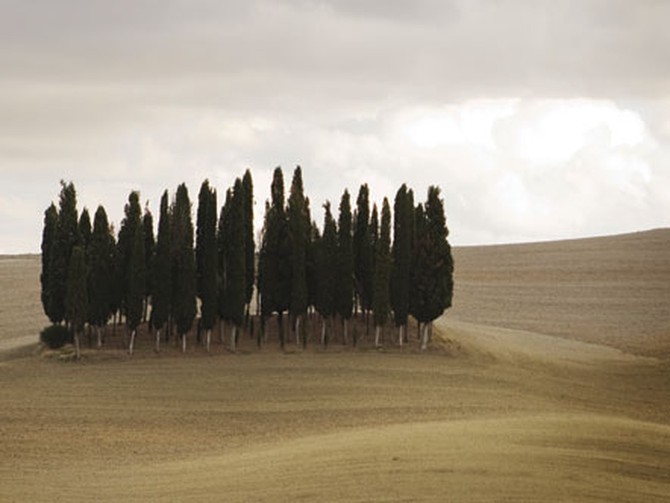
Montalcino, Tuscany,
Italy
Species: Cupressus sempervirens
Photographer: Allison Michael Orenstein
A close-ranked stand or line of cypresses is a familiar site in Tuscany, Italy; providing shade, signalling a boundary or carrying more potent symbolic weight alongside cemeteries. This landmark cluster seems bizarre in its location, as if only for decorative effect, in the middle of wheat fields near Montalcino, Tuscany, Italy.
From The Life & Love of Trees by Lewis Blackwell. Image © Allison Michael Orenstein
Photographer: Allison Michael Orenstein
A close-ranked stand or line of cypresses is a familiar site in Tuscany, Italy; providing shade, signalling a boundary or carrying more potent symbolic weight alongside cemeteries. This landmark cluster seems bizarre in its location, as if only for decorative effect, in the middle of wheat fields near Montalcino, Tuscany, Italy.
From The Life & Love of Trees by Lewis Blackwell. Image © Allison Michael Orenstein
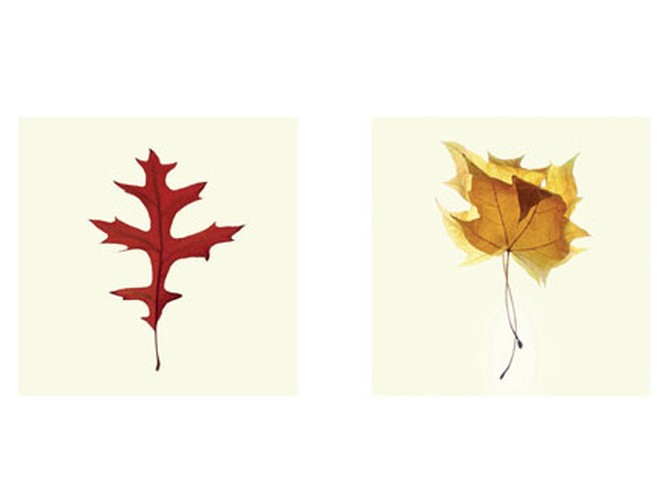
Eastern United States, Southern Canada
Species: Quercus coccinea
Photographer: Michael Swallow
The scarlet oak is easily confused with the pin oak and the red oak; sharp eyes are needed to spot that the leaves are hairless on the underside, while the sinuses between the lobes are even more marked than on the pin oak. Bucculatrix domicola caterpillars decline to eat it.
Species: Acer pseudoplatanus
Photographer: Michael Swallow
The sycamore leaf is one of the less colorful: in autumn it simply turns yellow and brown, curls up and dies. Popular in parks, as it is a handsome, large tree that tolerates a wide range of soils, its downside is that the heavy weight of leaf fall creates plenty of autumnal work for gardeners.
From The Life & Love of Trees by Lewis Blackwell. Image © Michael Swallow
Photographer: Michael Swallow
The scarlet oak is easily confused with the pin oak and the red oak; sharp eyes are needed to spot that the leaves are hairless on the underside, while the sinuses between the lobes are even more marked than on the pin oak. Bucculatrix domicola caterpillars decline to eat it.
Species: Acer pseudoplatanus
Photographer: Michael Swallow
The sycamore leaf is one of the less colorful: in autumn it simply turns yellow and brown, curls up and dies. Popular in parks, as it is a handsome, large tree that tolerates a wide range of soils, its downside is that the heavy weight of leaf fall creates plenty of autumnal work for gardeners.
From The Life & Love of Trees by Lewis Blackwell. Image © Michael Swallow
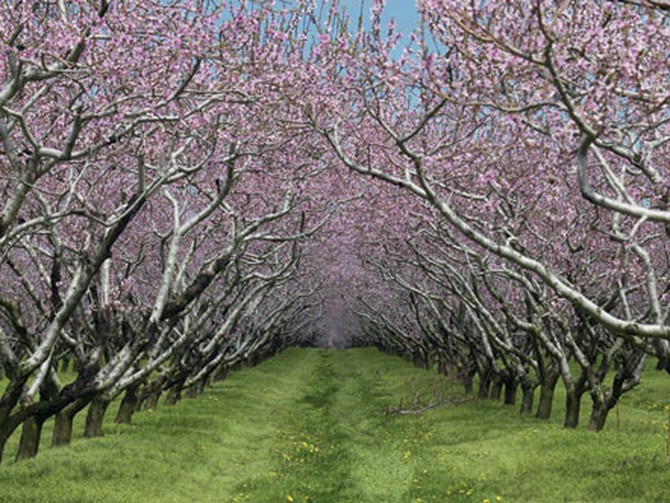
Ontario, Canada
Species: Prunus persica
Photographer: Chris Tomaidis
A nectarine orchard in bloom in the Niagara Peninsula of Ontario, Canada, is a beautiful and increasingly rare sight. The cultivation of peaches (nectarines are a kind of peach, but are a cultivar group with a recessive gene that prevents the growth of the fuzzy skin) is increasingly less commercially viable in Canada due to global competition and the marginal weather conditions of the region. Peaches originally came from China, but are now cultivated and farmed around the world, being the second largest fruit crop after apples in the United States.
From The Life & Love of Trees by Lewis Blackwell. Image © Chris Tomaidis
Photographer: Chris Tomaidis
A nectarine orchard in bloom in the Niagara Peninsula of Ontario, Canada, is a beautiful and increasingly rare sight. The cultivation of peaches (nectarines are a kind of peach, but are a cultivar group with a recessive gene that prevents the growth of the fuzzy skin) is increasingly less commercially viable in Canada due to global competition and the marginal weather conditions of the region. Peaches originally came from China, but are now cultivated and farmed around the world, being the second largest fruit crop after apples in the United States.
From The Life & Love of Trees by Lewis Blackwell. Image © Chris Tomaidis
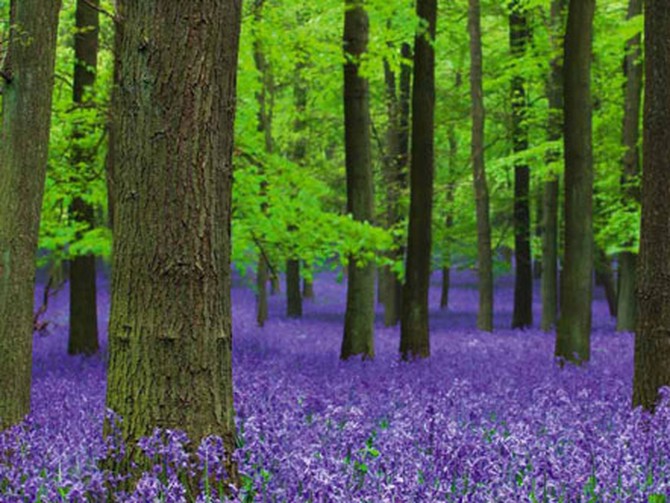
Ashridge in Hertfordshire, United Kingdom
Species: Hyacinthoides non-scripta
Photographer: Oxford Scientific
Bluebells have evolved to take advantage of the heavy leaf coverings typical of beech-dominated forests such as this one at Ashridge in Hertfordshire, United Kingdom. Bluebells flower early, typically in April and May, and so thrive ahead of the lowering of the light levels caused by the heavy summer-leaf canopy. This then restricts later-flowering competitive plants, giving bluebell seeds space to thrive in the next spring, quickly spreading to a dense carpet such as here.
From The Life & Love of Trees by Lewis Blackwell. Image © Oxford Scientific
Photographer: Oxford Scientific
Bluebells have evolved to take advantage of the heavy leaf coverings typical of beech-dominated forests such as this one at Ashridge in Hertfordshire, United Kingdom. Bluebells flower early, typically in April and May, and so thrive ahead of the lowering of the light levels caused by the heavy summer-leaf canopy. This then restricts later-flowering competitive plants, giving bluebell seeds space to thrive in the next spring, quickly spreading to a dense carpet such as here.
From The Life & Love of Trees by Lewis Blackwell. Image © Oxford Scientific
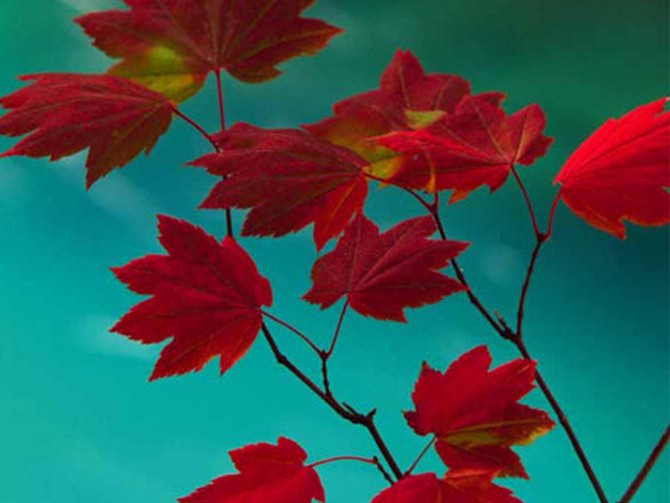
Mount Rainier National Park, Washington
Species: Acer circinatum
Photographer: Art Wolfe
The vine maple is a small tree or bush found from British Columbia down to northern California, United States. Here it overhangs a creek in Mount Rainier National Park, Washington, United States, displaying its tendency to bend over. At the extreme, the branches replant themselves and create a natural arch. Its attractive coloration has led to its propagation and distribution worldwide as an ornamental.
From The Life & Love of Trees by Lewis Blackwell. Image © Art Wolfe
Photographer: Art Wolfe
The vine maple is a small tree or bush found from British Columbia down to northern California, United States. Here it overhangs a creek in Mount Rainier National Park, Washington, United States, displaying its tendency to bend over. At the extreme, the branches replant themselves and create a natural arch. Its attractive coloration has led to its propagation and distribution worldwide as an ornamental.
From The Life & Love of Trees by Lewis Blackwell. Image © Art Wolfe
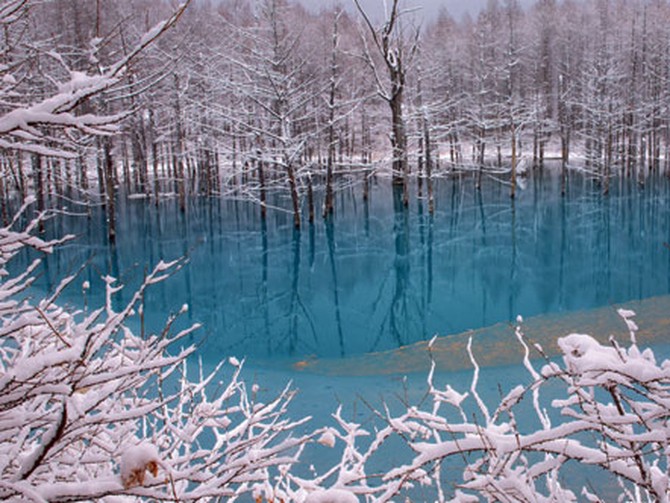
Hokkaido, Japan
Species: Various
Photographer: Tohoku Color Agency
This winter lakeside scene on Hokkaido, Japan’s second largest and most northerly island, reminds us of how trees are remarkable survivors: here a range of species withstand sub-zero temperatures and permanently wet conditions that could destroy most plants. In every climate zone, on every continent excluding Antarctica, trees have adapted to cope with, and often thrive in, testing conditions.
From The Life & Love of Trees by Lewis Blackwell. Image © Tohoku Color Agency
Photographer: Tohoku Color Agency
This winter lakeside scene on Hokkaido, Japan’s second largest and most northerly island, reminds us of how trees are remarkable survivors: here a range of species withstand sub-zero temperatures and permanently wet conditions that could destroy most plants. In every climate zone, on every continent excluding Antarctica, trees have adapted to cope with, and often thrive in, testing conditions.
From The Life & Love of Trees by Lewis Blackwell. Image © Tohoku Color Agency
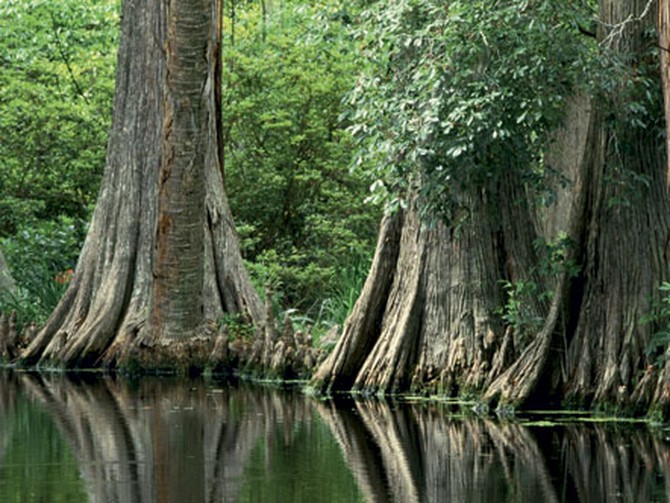
South Carolina
Species: Taxodium distichum
Photographer: Art Wolfe
The base of this bald cypress grove in South Carolina, United States, shows the strongly buttressed roots that connect to a broad root mat that helps the trees stay upright in the soft ground. The seeds of the tree are dispersed by animals, but they have also adapted to cope with floating across water to new sites.
From The Life & Love of Trees by Lewis Blackwell. Image © Art Wolfe
Photographer: Art Wolfe
The base of this bald cypress grove in South Carolina, United States, shows the strongly buttressed roots that connect to a broad root mat that helps the trees stay upright in the soft ground. The seeds of the tree are dispersed by animals, but they have also adapted to cope with floating across water to new sites.
From The Life & Love of Trees by Lewis Blackwell. Image © Art Wolfe
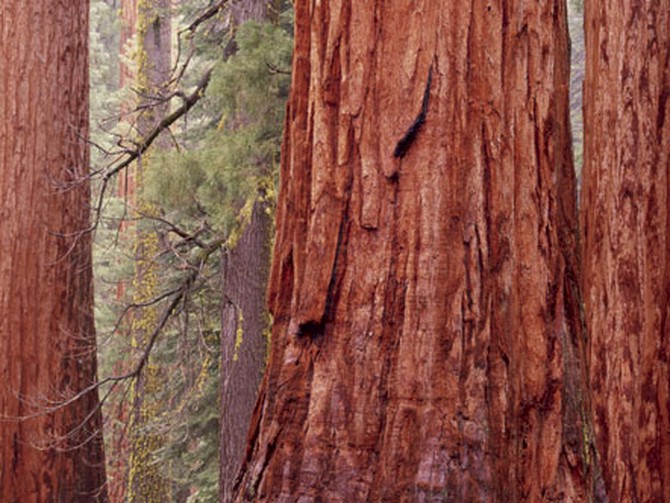
Yosemite National Park, California
Species: Sequoidendrom gigantum
Photographer: Art Wolfe
The magnificent size and age of the sequoia belies the fact that it has been reduced to inhabiting a small area of the world—the western slopes of the Sierra Nevada, as here in Yosemite National Park, California, United States. It does not need to reproduce often, but to do so requires unusual conditions. Fire is needed to clear the ground and create the right environment for the cones to spill their seed in fertile, light conditions. And then it needs space and to be left quietly alone for many years...all of which is hard to find outside of a national park.
From The Life & Love of Trees by Lewis Blackwell. Image © Art Wolfe
Photographer: Art Wolfe
The magnificent size and age of the sequoia belies the fact that it has been reduced to inhabiting a small area of the world—the western slopes of the Sierra Nevada, as here in Yosemite National Park, California, United States. It does not need to reproduce often, but to do so requires unusual conditions. Fire is needed to clear the ground and create the right environment for the cones to spill their seed in fertile, light conditions. And then it needs space and to be left quietly alone for many years...all of which is hard to find outside of a national park.
From The Life & Love of Trees by Lewis Blackwell. Image © Art Wolfe
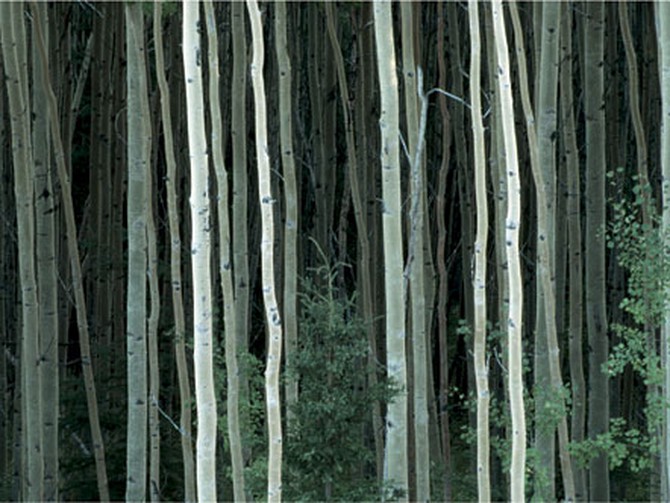
Tanana River Valley, Alaska
Species: Populus tremuloides
Photographer: Art Wolfe
The white bark of these aspens makes them seem to almost glow from within in the low northern light of the Tanana River Valley, Alaska. Aspens may seem delicate, with their fluttering leaves, but they are immensely successful, spreading across the boreal forests at the edge of the northern temperate zone. With their strong root system and ability to quickly clone, they often benefit from forest fires, being able to quickly regrow and take space from other species.
From The Life & Love of Trees by Lewis Blackwell. Image © Art Wolfe
Photographer: Art Wolfe
The white bark of these aspens makes them seem to almost glow from within in the low northern light of the Tanana River Valley, Alaska. Aspens may seem delicate, with their fluttering leaves, but they are immensely successful, spreading across the boreal forests at the edge of the northern temperate zone. With their strong root system and ability to quickly clone, they often benefit from forest fires, being able to quickly regrow and take space from other species.
From The Life & Love of Trees by Lewis Blackwell. Image © Art Wolfe
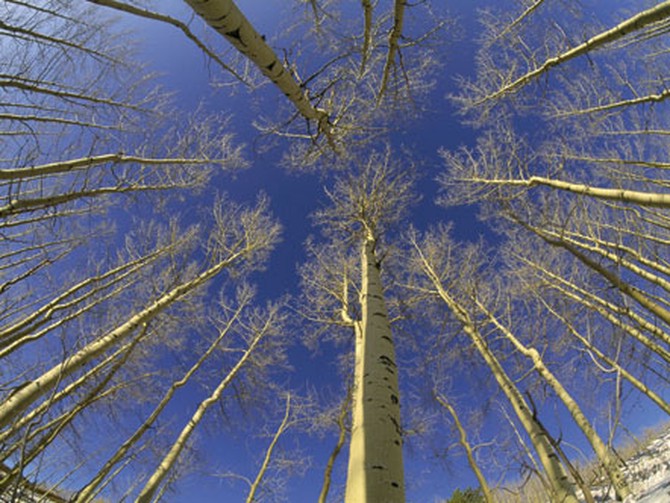
United States
Species: Populus tremuloides
Photographer: Art Wolfe
This grove of trembling aspens is also at its southern limit, requiring an environment that is not too hot in the day and is cold at night. The likelihood is that all the trees in this image are genetically identical, being clones of each other that have originally extended through roots throwing up new suckers. Aspens typically replicate in this way, and rarely through seed.
From The Life & Love of Trees by Lewis Blackwell. Image © Art Wolfe
Photographer: Art Wolfe
This grove of trembling aspens is also at its southern limit, requiring an environment that is not too hot in the day and is cold at night. The likelihood is that all the trees in this image are genetically identical, being clones of each other that have originally extended through roots throwing up new suckers. Aspens typically replicate in this way, and rarely through seed.
From The Life & Love of Trees by Lewis Blackwell. Image © Art Wolfe
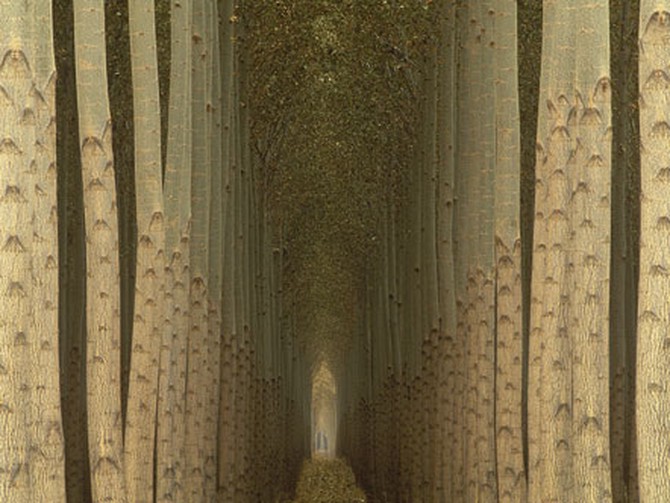
California, United States
Species: Unkown
Photographer: Richard Mack
This award-winning image is called "Tree Cathedral" by its photographer for good reason. Shot on a tree farm in California, United States, it shows a plantation of hybridized fast-growth poplar trees, and makes a powerful connection with gothic architecture. In doing so, it reminds us that trees and architecture have always been joined and not just through timber as a building material. Trees as structural inspiration have been there from classical antiquity through to the steel "trees" that hold up many contemporary airport terminals.
From The Life & Love of Trees by Lewis Blackwell. Image © Richard Mack
Get more information about The Life & Love of Trees at ChronicleBooks.com
Sign up for O's Quote of the Day newsletter for instant inspiration in your in-box
Photographer: Richard Mack
This award-winning image is called "Tree Cathedral" by its photographer for good reason. Shot on a tree farm in California, United States, it shows a plantation of hybridized fast-growth poplar trees, and makes a powerful connection with gothic architecture. In doing so, it reminds us that trees and architecture have always been joined and not just through timber as a building material. Trees as structural inspiration have been there from classical antiquity through to the steel "trees" that hold up many contemporary airport terminals.
From The Life & Love of Trees by Lewis Blackwell. Image © Richard Mack
Get more information about The Life & Love of Trees at ChronicleBooks.com
Sign up for O's Quote of the Day newsletter for instant inspiration in your in-box
From the November 2009 issue of O, The Oprah Magazine

